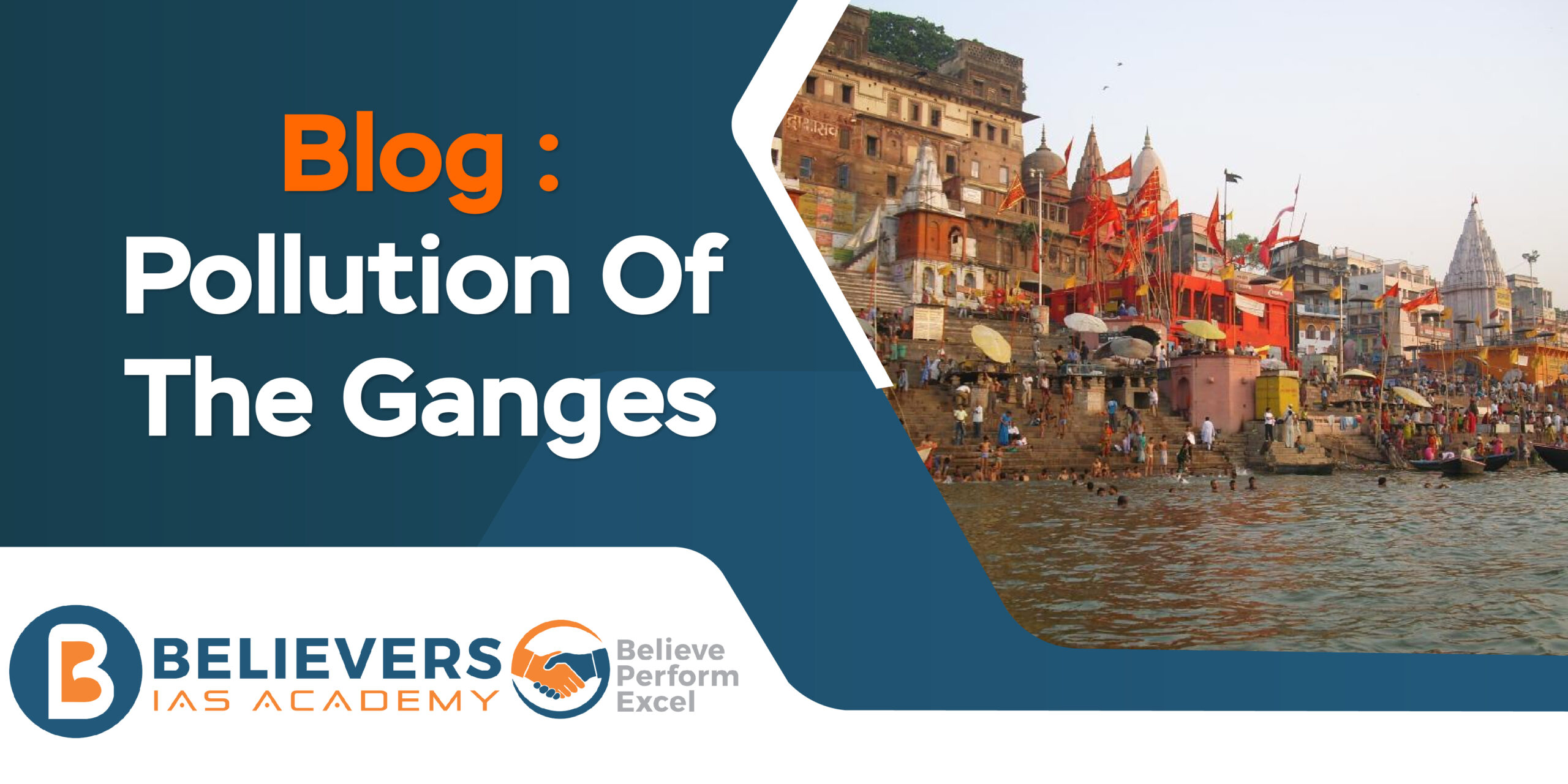Pollution Of The Ganges
Ganges Or The Ganga
- Hindus regard the Ganges as sacred and accord it great religious significance. It is revered as the goddess Ganga and is thought to purify the soul and atone for sins.
- Length and Course: The Ganges is one of the longest rivers in Asia, measuring over 2,525 kilometres (1,569 miles) in length. Its source is the Gangotri Glacier in the Indian state of Uttarakhand, and after passing through Bangladesh and northern India, it empties into the Bay of Bengal.
- Lifeline for Millions: The Ganges River basin is home to millions of people whose livelihoods depend on it. It supports a variety of economic activities, including fishing and agriculture.
- Ghats: Along the river’s course, there are many ghats (river access steps). These ghats are revered religious and cultural centres where pilgrims perform rites and rituals and take holy baths.
- Dolphins living in rivers: The susu, commonly referred to as the Ganges river dolphin, is found in the Ganges. These dolphins are among the world’s oldest and most vulnerable freshwater dolphin species.
The Ganges has long served as a source of inspiration for music, literature, and the arts. It has a particular place in the hearts of millions of people and is woven profoundly into India’s cultural fabric. But sadly the Ganga is one of the most polluted Rivers in the world.
Polluted Ganges
- Threats from pollution: The Ganges River in India is seriously contaminated with industrial pollutants and human waste, causing serious risks to human health and the environment as a whole.
- Impact on Population: Across 11 states in India, the Ganges River supplies water to almost 40% of the country’s inhabitants. It is the river that provides services to the biggest number of people in the world, an estimated 500 million people.
- Ranking: The Ganges River is currently ranked as the fifth-most polluted river in the world. Because of the buildup of industrial pollutants and human waste, it is now extremely polluted.
- Late Acknowledgement: It took until the late 1970s for the contamination of the Ganges to get major attention. However, before people began to recognise it, pollution in the river had been a constant and ongoing process for a very long time.
- Environmentally Dead Zones: Due to pollution, parts of the Ganges River that extend more than 600 kilometres (370 miles) have virtually turned into environmentally dead zones. This indicates that these places lack the ecological balance and biodiversity needed to maintain aquatic life.
- projects and Failure: Over the years, several projects to clean the Ganges River were launched, however, none of them were very successful. The ecosystem and public health continue to be threatened by excessive pollution levels, despite the efforts undertaken to reduce them.
Consistent and thorough efforts are needed to address the Ganges River’s pollution. This entails putting in place efficient systems for treating wastewater, controlling industrial discharge into rivers, and educating people about the need of preserving and safeguarding this precious water resource.
What were the causes of the Ganges getting polluted?
- Disposal of human sewage and animal waste:
-
-
- Numerous cities and towns with dense populations are traversed by the Ganges River.
- These people frequently discharge sewage water into rivers, including domestic waste and sewage from sanitation.
- Additionally polluting the river is animal excrement that results from farming and livestock operations.
-
- Disposal of industrial waste:
-
-
- Along the Ganges, there are several industrial cities, including Kanpur, Prayagraj, Varanasi, and Patna.
- Hospitals, slaughterhouses, distilleries, textile mills, tanneries, and chemical factories all discharge untreated sewage into rivers.
- About 12% of the entire amount of sewage entering the Ganges is made up of industrial effluents, which are frequently poisonous and non-biodegradable.
- Pollution is also a result of plastic waste and wastewater from nearby factories.
-
- Religious customs and practises:
-
-
- During festival times, a large number of people congregate to take a bath in the Ganges to seek spiritual purification.
- During these rites, debris including food, waste, and leaves is dumped into the river, increasing its pollution.
- Half-burnt bodies are the result of the custom of cremating bodies on riverbanks and dumping the remains into the Ganges, further polluting the water.
-
- Dams and barrages:
-
-
- The Haridwar dam, constructed under British colonial rule in India, substantially restricted the Ganges’ flow, causing it to deteriorate.
- Originally built to redirect water into the Hooghly River, the Farakka Barrage has increased salinity downstream, harming groundwater and soil.
- The Ganges’ natural flow has been hampered by the construction of dams and barrages, which has strained relations between Bangladesh and India.
- The river’s flow and diluting ability are further decreased by several barrages and pumping stations, which raises pollution levels.
-
- Lack of minimal environmental flow:
-
- During dry seasons, excessive water withdrawal for agricultural purposes depletes the river.
- Pollution builds up because there is not enough water to dilute the filthy inflows from habitations and industries downstream.
How is pollution affecting different forms of life??
- Blue Life:
-
-
- The Ganges basin’s fish muscles have high amounts of mercury deposition, with between 50 and 84 per cent of it being organic mercury, according to a mercury assay.
- The bioaccumulation of mercury in the food chain is indicated by the mercury levels in fish muscles showing a positive association with dietary choices and fish length.
-
- Endangered Species:
-
-
- One of the few freshwater dolphin species in the world, the Ganges River dolphin is designated as endangered, with a population estimated to be less than 2000. Their migration is disrupted and their population is diminishing as a result of the development of irrigation and electrical dams along the Ganges.
- Due to heavy metal contamination in the Ganges, the Ganges softshell turtle—found in the Ganges, Indus, and Mahanadi river systems—is vulnerable. Due to their lengthy lifetime and high trophic level, turtles are particularly vulnerable to the negative impacts of pollution.
-
- Wildlife:
-
-
- Animal habitat is being lost as a result of the construction of dams in the Ganges basin, which causes significant forest areas to be submerged.
- Ecologically Dead Zones: As a result of pollution, certain stretches of the Ganges River, spanning over 600 kilometres (370 miles), have essentially become ecologically dead zones. This means that these areas lack the necessary biodiversity and ecological balance to support aquatic life.
-
- Human Life:
-
- A study of the Ganges water has revealed strong links between common water-borne behaviours like bathing, doing laundry, washing dishes, eating, cleaning utensils, and brushing teeth in the river.
- Dysentery, cholera, hepatitis, and severe diarrhoea have all been associated with drinking Ganges water, which is still a major cause of death for children in India.
- Even though aquatic illnesses are common, parents of sick children rarely mention their child’s river exposure while seeking medical care
What are the steps or actions taken by the government?
-
- Ganga Mahasabha:
- The Ganga Mahasabha is an Indian organisation devoted to the protection and welfare of the Ganges River. It was established in 1905 by Madan Mohan Malaviya.
- The constant flow of the Ganges, which is seen as a fundamental right by Hindus, is its principal goal.
- On November 5, 1914, British India decided to recognise the Ganges’ uninterrupted flow; this date is now recognised as “Aviral Ganga Samjhauta Divas” or “Uninterrupted Ganga Flow Agreement Day.”
- On December 19, 1916, the Agreement of 1916, which formally recognised this right, was established.
- Despite the agreement’s legal legitimacy, India’s state and federal governments have not preserved their sanctity since the country’s independence, which has resulted in increased pollution and river deterioration.
- Ganga Mahasabha:
- Ganga Action Plan (GAP)
-
-
- Prime Minister Rajiv Gandhi introduced the Ganga Action Plan (GAP) in June 1986 to enhance the Ganges’ water quality.
- 25 Class I towns were initially included in the plan, with 6 in Uttar Pradesh, 4 in Bihar, and 15 in West Bengal.
- Its goals included preventing toxic and industrial chemical waste from entering the river as well as intercepting, redirecting, and treating domestic sewage.
- The plan also included the development of sewage treatment technologies, research and development for biodiversity conservation, and control of non-point sources of pollution.
- The GAP sought to investigate resource recovery possibilities, such as aquaculture and methane generation, and to rehabilitate soft-shelled turtles to reduce pollution.
-
- Namami Gange Programme:
-
- The Namami Gange Programme, an integrated Ganges development project, was introduced in July 2014.
- It seeks to efficiently reduce pollution, protect the Ganges, and restore it.
- The programme involves several activities to accomplish its goals and encompasses eight states.
- One of the goals of the Ministry of Drinking Water Supply and Sanitation is to eradicate open defecation from 1,674-gramme panchayats (village councils) close to the Ganges.
- The river has received significant funding for cleanup, with more than 2,958 Crores (US$460 million) spent as of July 2016.
- To reduce pollution, the programme mandated the closure of 48 industrial facilities along the Ganges.
- The Namami Gange Programme will spend 20,000 crore over the next five years, which is a huge increase over prior initiatives.
- It places a strong emphasis on coordination between federal and state government ministries and agencies and seeks to address pollution hotspots through public-private partnerships (PPPs).
- Interventions to reduce pollution, infrastructure for sewage treatment, riverfront development, river surface cleaning, biodiversity conservation, reforestation, public education, and industrial effluent monitoring are the main areas of focus for the programme.
- Jobs will be created, livelihoods will be enhanced, and populations reliant on the Ganges will have better health as a result of the programme.
These programmes are a reflection of ongoing efforts to clean up and safeguard the Ganges River, preserve biodiversity, reduce pollution, and enhance the socioeconomic standing of those who live nearby.





